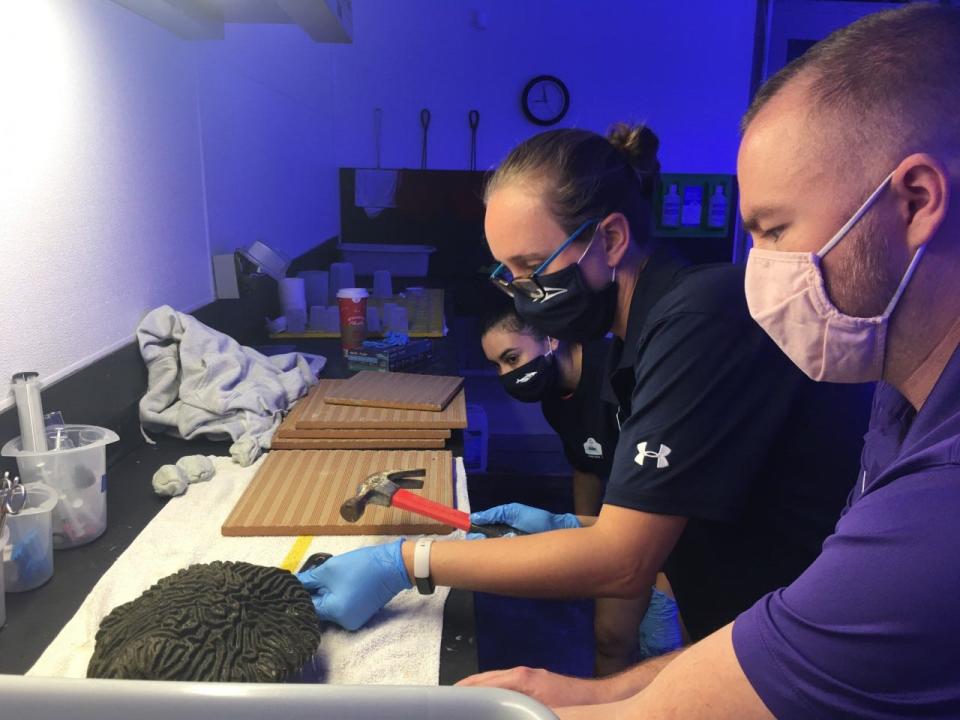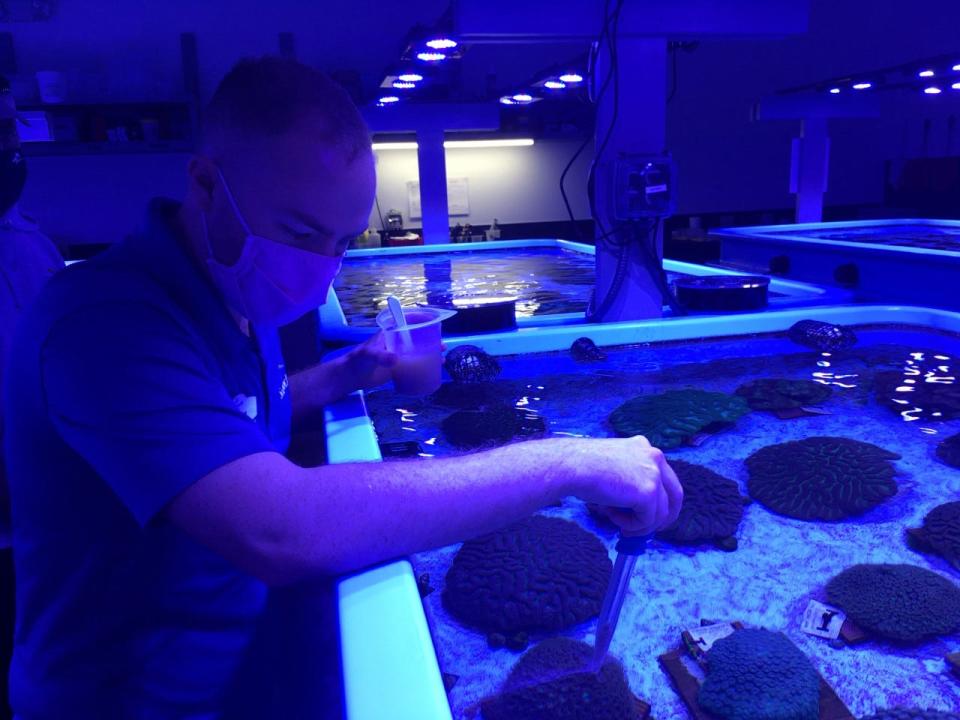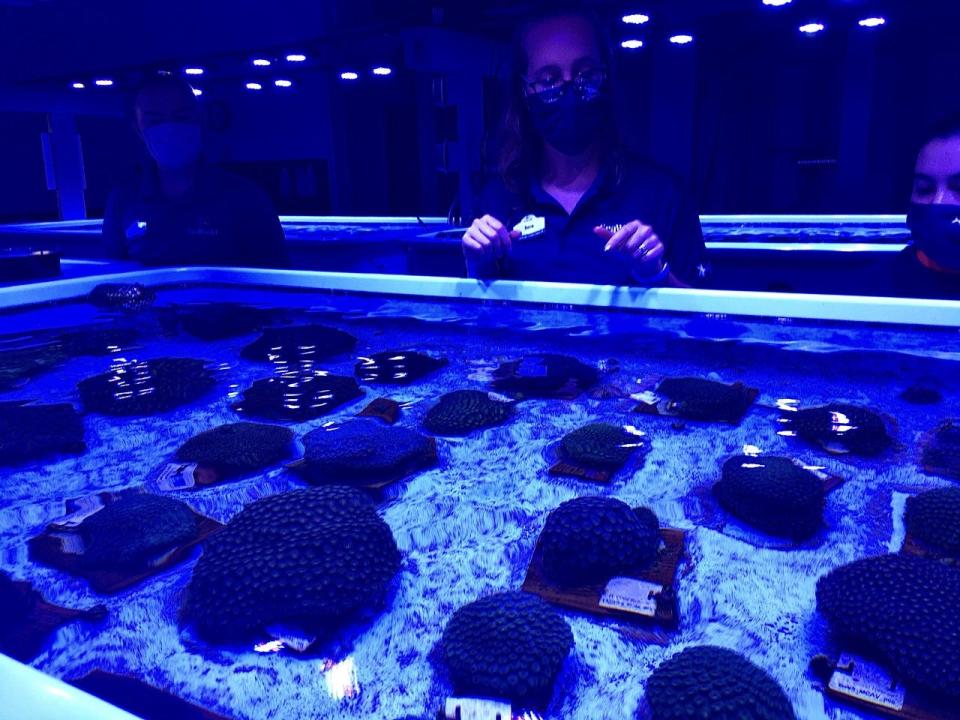'Daring' coral rescue as officials attempt to safeguard genetics of Florida reef tract
Support local journalism by getting a digital subscription to The Palm Beach Post. For a limited time, new subscribers can get full digital access for six months for only $1. Sign up here.
In a drab Orlando industrial park behind a string of car dealerships, a Noah’s Ark-like rescue is underway to safeguard Florida’s coral from annihilation.
Under the doting care of scientists at the Florida Coral Rescue Center are 683 colonies chiseled out of harm’s way ahead of a racing scourge of stony coral tissue loss disease.
The loathsome killer of the ocean’s most precious living gems was discovered in 2014 and has decimated Florida’s reef tract as far as the Dry Tortugas with a 90% mortality rate.
The coral center, located in a back bay of the Orangewood Business Park, accepted its first coral refugees in March 2020 with a goal to protect the reef builders’ genetic diversity. It’s a novel undertaking in its breadth and swift mobilization, which included multiple federal, state and private entities rallying to salvage what coral they could.
More: How 'happy coral' is thriving in a trashy, polluted port thrashed by cruise ships
More: 'We were gobsmacked': Great hammerhead shark nursery discovered in urban area of Florida
“This was a case study in crisis response that moved very quickly,” said Florida Fish and Wildlife Conservation Commission South Region Director Thomas Reinert. “It was an amazing collaborative effort.”
About 30% of the corals rescued are housed at the center in Orlando, with 25 other aquariums, zoos and universities from Nashville to New Hampshire caring for smaller collections.

Four SeaWorld Orlando biologists care for the 18 species of coral at the center. Awash in an ultraviolet light that casts a sci-fi blue throughout the bay, they hand-feed droppers of krill to hungry coral, provide snacks of oyster eggs, and monitor the water chemistry, plumbing and temperature of 16, 300-gallon tanks. Two additional tanks are 100 gallons each.
“We know that this is all ground-breaking work,” said SeaWorld coral biologist Aaron Gavin, noting that some of the coral species haven't been held in captivity before and are not common in hobbyist aquariums. “I might do something today that’s never been done before and that’s very exciting.”
There’s also a level of stress involved considering they are shepherding the genetic bank of the Florida reef tract. They've learned some corals have their own eccentricities, like wanting to be fed in the dark. So, the biologists don headlamps to feed them in the facility they call the coral Club Med.

Only two corals at the facility have perished.
“There is definitely pressure to keep them healthy,” said SeaWorld coral biologist Sara Spangler. “It was a lot of babying them in the beginning.”
The center's corals include star, flower cactus and four species of brain coral - all stony corals with limestone skeletons that are the building blocks for reefs.
MORE: Hurricanes Dorian and Barry were scary but here's how they helped the environment
MORE: Dorian left Bahamas coral battered, littered with trash
Wildlife officials created a Florida Coral Rescue Team in the summer of 2018 realizing they needed to remove healthy corals before they were infected by the advancing line of tissue loss disease. The plan included collecting and caring for 22 species of coral in the hopes of restoring the Florida reef tract in the future.

The Association of Zoos and Aquariums helps oversee the project, which includes FWC, NOAA fisheries, SeaWorld, the Disney Conservation Fund and the Fish and Wildlife Foundation of Florida.
It was lucky coincidence that a bay used by a private coral company came available at the industrial park complete with equipment that the foundation purchased with donated money. The element of anonymity – there is no sign heralding the Florida Coral Rescue Center – helps protect the investment. The center is also not open to the public so there’s no need to advertise.
More: Jupiter is hot spot for sharks munching on line-caught fish; now what can be done about it?
“It took about four months to get the facility ready to start accepting corals in the spring of 2020,” said Andrew Walker, president and CEO of the Fish and Wildlife Foundation.
Walker called the project “daring” and “unprecedented.”
“Globally, I believe the era of completely self-sustaining coral reefs is largely over, particularly with climate change and coral bleaching occurring increasingly frequently, as well as local problems of siltation, direct reef damage, pollution and other stresses,” Walker said.
Each coral at the rescue center sits on its own terracotta tile. Some are growing so fast they’ve overwhelmed their original tiles and are getting new ones.
Justin Zimmerman, aquarium supervisor for SeaWorld Orlando, said the growth spurts were unexpected but they don’t know if the corals are just thriving in the pampered environment or would grow similarly in the wild if stony coral tissue loss disease wasn't so prevalent.
Scientists are still trying to determine the cause of the disease, which spread quickly following its initial identification in 2014 at Virginia Key near Miami. By the summer of 2016 it had reached Palm Beach County and was well past Key West in 2019. Corals throughout the Caribbean are also suffering from the plague.
This summer, the center hopes to get the corals to spawn – a tricky endeavor that includes mimicking the amount of light they would get naturally in the Keys as the seasons change.
“Once the disease goes through, they’re going to need a lot of baby coral,” Zimmerman said.
Kimberly Miller is a veteran journalist for The Palm Beach Post, part of the USA Today Network of Florida. She covers weather, climate and the environment and has a certificate in Weather Forecasting from Penn State. Contact Kim at kmiller@pbpost.com
Support local journalism by getting a digital subscription to The Palm Beach Post. For a limited time, new subscribers can get full digital access for six months for only $1. Sign up here.
This article originally appeared on Palm Beach Post: Stony coral tissue loss disease maims Florida reef but rescue underway

